
East-German postcard by VEB Progress Film-Vertrieb, Berlin, no. 1901, 1963. Photo: Ludwig Schirmer.

East-German postcard by VEB Progress Film-Vertrieb, Berlin, no. 2569, 1966. Photo: Arno Fischer.

East-German postcard by VEB Progress Film-Vertrieb, Berlin, no. 3239, 1968. Photo: DEFA / Dietrich.
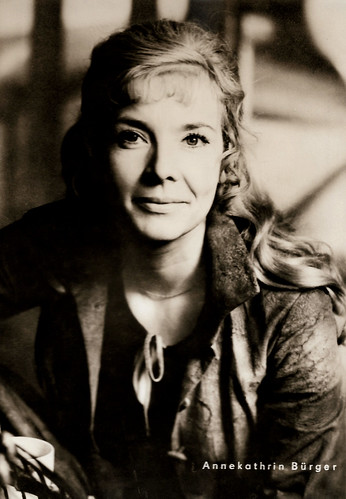
East-German postcard by VEB Progress Film-Vertrieb, Berlin, no. 9/72. Photo: Schütz. Annekathrin Bürger in Tecumseh (Hans Kratzert, 1972).
Unprecedentedly libertine in regards to sexuality
Annekathrin Bürger was born Annekathrin Rammelt in 1937 in Berlin-Charlottenburg, Nazi Germany. Her father was the animal draftsman and illustrator Heinz Rammelt.
She grew up in Hornhausen, trained as an advertising designer in Bernburg, and worked as a stage design assistant, prop master, and extra at the Carl-Maria-von-Weber-Theater there. She failed the entrance exam for the State Drama School in Berlin.
In the summer of 1955, she met Czech film people in Berlin and played her first small role as a pioneer leader in the Czech-German short film Gebirge und Meer/Mountains and sea (Wolfgang Bartsch, Bohumil Vosahlik, 1955).
A year later she appeared in the East German neo-realist romantic drama Eine Berliner Romanze/A Berlin Romance (Gerhard Klein, 1956), a film about youth urban life in the divided city of Berlin. It was produced by the DEFA, the state-owned East German studio. Annekathrin Bürger's co-stars were Ulrich Thein and Uwe-Jens Pape. It is still amongst DEFA's best-known films.
Bürger studied acting at the Potsdam Film and Television Academy from 1957 to 1960. From 1959 to 1960 she was engaged at the Deutsches Theater in Berlin. She also starred in another youth film, Reportage 57 (János Veiczi, 1959), and the romantic comedy Verwirrung der Liebe/Love's Confusion (Slátan Dudow, 1959), both with Willi Schrade. Love's Confusion was Dudow's last film and the screen debut of Angelica Domröse. Influenced by the relaxed political climate ushered with the Khrushchev Thaw, the picture was unprecedentedly libertine in regards to sexuality. It became a huge hit.
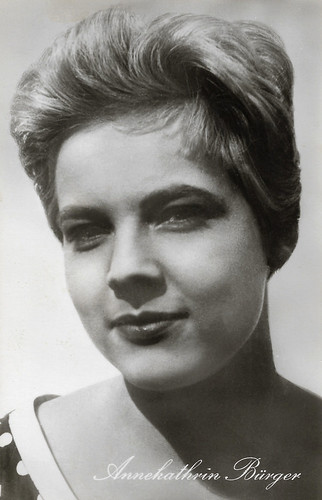
East-German postcard by VEB Progress Film-Vertrieb, Berlin, no. 639, 1958. Photo: Gerhard Puhlmann.

East-German postcard by VEB Progress Film-Vertrieb, Berlin, no. 710, 1958. Photo: Günther Ost.

East-German postcard by VEB Progress Film-Vertrieb, Berlin, no. 1.327 F, 1960. Photo: DEFA - Neufeld.

East-German postcard by VEB Progress Film-Vertrieb, Berlin, no. 2087, 1964. Photo: Ludwig Schirmer.

East-German postcard by VEB Progress Film-Vertrieb, Berlin, no. 2.253, 1965. Photo: DEFA / Schirmer.
The only DEFA film looking at Nazi Germany history in East Germany
During the early 1960s, Annekathrin Bürger appeared in a series of DEFA productions, such as Septemberliebe/September Love (Kurt Maetzig, 1961) with Doris Abesser and Ulrich Thein.
She also starred in the first joint Soviet–East German film, Pyat Dney, Pyat Nochei/Fünf Tage, Fünf Nächte/Five Days, Five Nights (Lev Arnshtam, Heinz Thiel, 1961) with Wilhelm Koch-Hooge.
The picture's plot was inspired by the recovery of the art of the Old Masters Picture Gallery through the hands of Soviet troops in 1945. The art collection was then taken to the USSR, where it was kept until being returned to the Dresden Gallery in 1960. Five Days, Five Nights sold more than two million tickets in the German Democratic Republic.
Then she starred in the romantic war drama Königskinder/Star-Crossed Lovers (Frank Beyer, 1962) with Armin Mueller-Stahl, and in the drama Das zweite Gleis/The Second Track (Joachim Kunert, 1962), as the daughter of Albert Hetterle. It is the only DEFA film looking at Nazi Germany history in East Germany.
From 1963 to 1965 Annekathrin Bürger was a member of the DFF, from 1965 to 2003 a member of the ensemble of the Volksbühne Berlin. Since 1968 she has only seldom been used in supporting roles in the theatre.

East-German postcard by VEB Progress Film-Vertrieb, Berlin, no. 2263, 1965. Photo: Schirmer.

East-German postcard by VEB Progress Film-Vertrieb, Berlin, no. 2.313, 1965. Photo: DEFA / Bergmann.

East-German postcard by VEB Progress Film-Vertrieb, Berlin, no. 2.606, 1966. Photo: Arno Fischer.

East-German postcard by VEB Progress Film-Vertrieb, Berlin, no. 57/69, 1969. Photo: Klaus D. Schwarz.
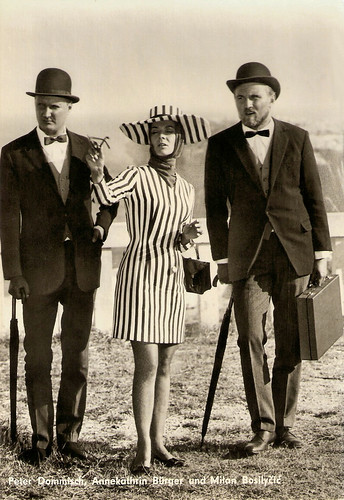
East-German postcard by VEB Progress Film-Vertrieb, Berlin, no. 80/69, 1969. Photo: Zähler / DEFA. Milan Beli (as Milan Bosiljcic) at right, Annekathrin Bürger and Peter Dommisch at left in Mit mir nicht, Madam!/Now ith me, Madam! (Roland Oehme, Lothar Warneke, 1969).
A more critical and realistic view of American expansion to the West
Annekathrin Bürger played numerous roles in DEFA and DFF films including the Ostern (Red Western) Tecumseh (Hans Kratzert, 1972) opposite Gojko Mitić and Rolf Römer.
It is part of a popular string of films starring the Yugoslav actor Gojko Mitić which, in line with the policies of Communist East Germany, attempted to present a more critical, but also more realistic, view of American expansion to the West than was characterised by Hollywood.
The film, along with others, was also made partly in response to the successful series of Karl May films made in West Germany. The film depicts the life of the Native American leader Tecumseh (1768–1813), including his role in Tecumseh's War and his later death in the War of 1812 while fighting with the British against the United States.
On television, she played a supporting role as a laundromat and bar manager in the popular series Tatort Leipzig with Peter Sodann, until 2005. She was also involved in cultural policy and protested against Wolf Biermann's expatriation and was committed to maintaining Charlotte von Mahlsdorf's Wilhelminian-style museum.
From 1990 to 1997 Bürger was chairman of the Congress of the National Citizens Movement. In 1993 she and her husband founded the orphans on the Don association. In the same year, the documentary film Children of the Don was made about it.
Annekathrin Bürger was first married to the actor and director Ulrich Thein and was married to her colleague Rolf Römer from 1966 until his death in 2000. Annekathrin Bürger lives in Berlin-Köpenick.
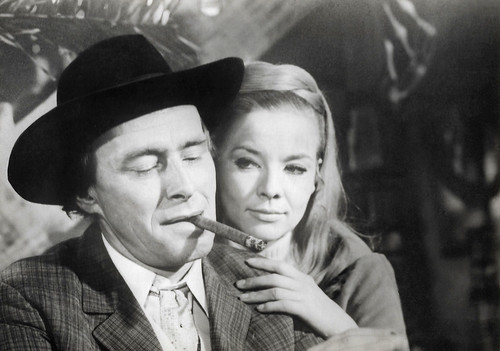
East-German postcard by VEB Progress Filmvertrieb, Berlin, no. 85/70e, 1970. Photo: DEFA / Blümel. Bruno O'ya and Annekathrin Bürger in Tödlicher Irrtum/Fatal Error (Konrad Petzold, 1970).

East-German postcard by VEB Progress Film-Vertrieb, Berlin, no. 131/70, 1970. Photo: Linke.

East-German postcard by VEB Progress Film-Vertrieb, Berlin, no. 50/72. Photo: DEFA / Zilmmer. Mieczyslaw Kalenik, Annekathrin Bürger and Milan Beli in Tecumseh (Hans Kratzert, 1972).
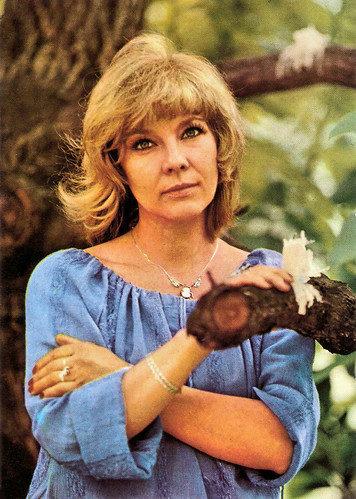
East-German postcard by Progress Film-Verleih, Berlin / Planet-Verlag, no. 10/F/78, 1978. Photo: Schwarz.

German autograph card.
Sources: Wikipedia (English and German), and IMDb.
No comments:
Post a Comment